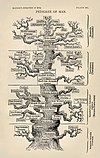User:Abyssal/Portal:Permian
|
IntroductionSelected article on the Permian world and its legacies
Starfish or sea stars are echinoderms belonging to the class Asteroidea. About 1,500 living species of starfish occur on the seabed in all the world's oceans, from the tropics to subzero polar waters. They are found from the intertidal zone down to abyssal depths, 6,000 m (20,000 ft) below the surface.
Starfishes typically have a central disc and five arms, though some species have more than this. The aboral or upper surface may be smooth, granular or spiny, and is covered with overlapping plates. Starfish have tube feet operated by a hydraulic system and a mouth at the centre of the oral or lower surface. They are opportunistic feeders and are mostly predators on benthicinvertebrates. Several species having specialized feeding behaviours including eversion of their stomachs and suspension feeding. They have complex life cycles and can reproduce both sexually and asexually. Most can regenerate damaged parts or lost arms and they can shed arms as a means of defence. The Asteroidea occupy several significant ecological roles. The fossil record for starfish is ancient, dating back to the Ordovician around 450 million years ago, but it is rather poor, as starfish tend to disintegrate after death. Only the ossicles and spines of the animal are likely to be preserved, making remains hard to locate. (see more...) Did you know?
Need help?Do you have a question about Abyssal/Portal:Permian that you can't find the answer to? Consider asking it at the Wikipedia reference desk. Selected image
Selected article on the Permian in human science, culture and economics In 1858, Charles Darwin and Alfred Russel Wallace published a new evolutionary theory that was explained in detail in Darwin's On the Origin of Species (1859). Unlike Lamarck, Darwin proposedcommon descent and a branching tree of life. The theory was based on the idea of natural selection, and it synthesized a broad range of evidence from animal husbandry, biogeography, geology, morphology, and embryology. The debate over Darwin's work led to the rapid acceptance of the general concept of evolution, but the specific mechanism he proposed, natural selection, was not widely accepted until it was revived by developments in biology that occurred during the 1920s through the 1940s. Before that time most biologists argued that other factors were responsible for evolution. The synthesis of natural selection with Mendelian genetics during the 1920s and 1930s founded the new discipline of population genetics. Throughout the 1930s and 1940s, population genetics became integrated with other biological fields, resulting in a widely applicable theory of evolution that encompassed much of biology—the modern evolutionary synthesis. (see more...) GeochronologyEpochs - Cisuralian - Guadalupian - Lopingian Geography - Pangaea - Panthalassa Stratigraphic units - Red Beds of Texas and Oklahoma Researchers - Edward Drinker Cope SubcategoriesQuality ContentFeatured Permian articles - Amphibian Things you can doRelated contentAssociated WikimediaThe following Wikimedia Foundation sister projects provide more on this subject:
|






















